How To Repair A Psoas Mscle Tear
The psoas muscle is an important musculus located in your lower back or lumbar region. Tension in the psoas musculus or injury to it can be a crusade of low back pain and discomfort. Knowing how to release the psoas muscle is one of the ways to ease back pain and tension. Notwithstanding, the musculus is deep within your core and it's not always easy to stretch or practice the psoas muscle.
Usually, the best way to salve hurting and tension in your psoas is to perform various stretching exercises. Stretching your back, spine, and your leg muscles can help to release a tight psoas muscle and ease lower back hurting. In some cases, physical therapy with a specialist is needed to release the muscle and relieve tension.
In this article, I will wait at what exactly the psoas musculus does and the important role it has in your core muscles. If you lot suffer from lumbar hurting, so yous will find helpful stretching exercises for psoas muscle hurting and tension relief.
What is the Psoas Muscle?
The psoas musculus connects your upper body with your legs and is one of the important muscles in your cadre.
According to MedicineNet: "There are two psoas muscles on each side of the back. The larger of the 2 is called the psoas major and the smaller the psoas minor. The psoas major originates at the spine around the lesser of the rib cage and runs down to the thigh bone (the femur). The psoas pocket-sized also originates at the spine around the lesser of the rib cage but information technology runs downwardly to the bony pelvis. It acts to flex the lower (lumbar) spine."
The Journal of the American Osteopathic Association says that the psoas muscles attache to your vertebrae in your thoracic spine and lumbar region. These are the only muscles in your torso that attach your legs to your spine. The psoas muscle is important because it allows you to bend your legs frontwards – for example, when running, walking, or going upstairs.1
The psoas major muscle connects with the iliacus muscle which is located in your hip bone. Together they both form the iliopsoas muscle. In that location are likewise fretfulness and ligaments that connect to your psoas and iliacus muscles.1
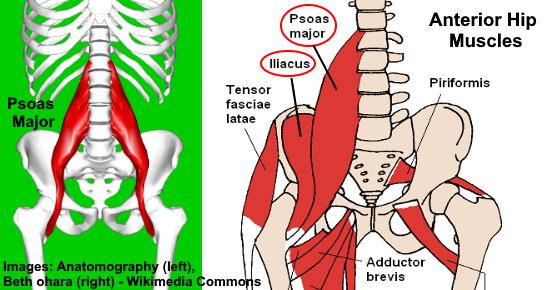
What the Psoas Musculus Does
The primary function of the psoas muscle is to give your body stability, force, and help proceed your residue.
Co-ordinate to the Journal of the Canadian Chiropractic Association, the psoas major muscle is mainly used to flex the hip articulation. Information technology is also the major musculus that flexes and stabilizes the lumbar spine and provides strength to your lower back.ii The psoas minor acts to flex the lower (lumbar) spine helping you bend forward.
Anytime you walk, run, curve over to selection something upward, or fifty-fifty stand still, your psoas muscles help to stabilize you.
Information technology'due south important to release psoas muscle hurting naturally because you lot tin terminate up with more aches and chronic dorsum and leg pain. If you have muscle imbalances, y'all tend to overuse other muscles to compensate for the hurting. This can atomic number 82 to strained or torn muscles in your center back, legs, or other areas of your torso.
Symptoms of Psoas Muscle Pain or Strain
Psoas muscle pain is often referred to equally psoas syndrome, and the most common symptom of psoas muscle strain is lower back pain. The Journal of the Canadian Chiropractic Association commented that pain in the lower back tin can feel abrupt and jabbing and may become worse if yous put actress weight on your right or left leg.2
Pain from tight or tense psoas muscles may also radiate to other parts of your body. For example, the Journal of the American Osteopathic Association reported that pain tin can oftentimes start in the lumbar spine area and spread down ane or both legs to the articulatio genus. Tension in your core muscles like the psoas muscles can also make information technology difficult to stand straight upright, and you lot may as well experience pain in the buttocks or hips.1
There are also symptoms of psoas hurting that are related to your internal organs. For example, appendicitis or kidney stones tin cause irritation of the psoas muscle. Likewise, psoas muscle syndrome tin affect your animate because psoas musculus dysfunction can likewise affect your diaphragm.1
Psoas musculus pain and tension tin can cause back pain and difficulty continuing upwardly, especially if you lot accept been sitting for long periods of time.
Doctors from the Cleveland Dispensary say that other symptoms of a tight psoas muscle can include:3
- Lumbar pain when you lot move position later on sitting for lengthy periods of fourth dimension
- Pain when continuing erect
- Pain that radiates to your buttocks or down 1 or both legs
- Groin or pelvic hurting
- Walking with a limp or finding it difficult to lift your feet when walking
Of course, there tin can be many other reasons for low dorsum hurting. For example, kidney stones, gallstones, sciatic pain, IBS, or prostatitis (in men), can all be reasons for agonized discomfort in your lower back.
Dorsum Pain and the Psoas Muscle
Back hurting acquired by weak or injured psoas muscles can exist debilitating and affect your full general feeling of well-beingness.
At that place are many reasons why psoas musculus dysfunction tin can lead to dorsum pain and other associated symptoms. According to the European Spine Journal, non using your muscles enough can lead to weak muscles. And then, sitting for long periods of time means that your psoas muscles are always in a flexed state. This can outcome in tight psoas muscles.4
The European Spine Journal also noted that herniated spinal discs tin be another reason for low dorsum pain that is connected to the psoas muscles. Usually, patients with spinal dysfunction restrict movement in their lower back, which leads to the psoas muscles being tight and in a constant shortened state.4
This tin lead to the formation of myofascial trigger points besides knows as trigger points. According to the trigger point model, unexplained pain ofttimes radiates from these points of local tenderness to broader areas, sometimes distant from the trigger point itself.
The journal Current Pain and Headache Reports explained that overusing muscles or muscle injury can cause tender points in hardened bands of muscle. Trigger points cause referred hurting to other areas of your trunk and tin be a reason for acute or chronic pain spreading from your lower back.
Trigger points can feel similar knots, and it's important to stretch the musculus properly to release the tension and hurting acquired by trigger points. Doctors say that this helps to increase blood circulation to the affected area and helps speed up the healing procedure.
According to the Periodical of Manual and Manipulative Therapy, some of the sensations that trigger points tin cause are:5
- Tingling in other parts of your trunk
- Numbness in a limb
- Referred pain that spreads from the tight musculus
How to Release a Tight Psoas Muscle
Considering the psoas muscle is located deep in your core, it can exist a challenge to release a tight psoas musculus to relieve hurting and backaches.
The Journal of the American Osteopathic Association recommends various forms of concrete therapy to help care for psoas syndrome. Diverse stretching exercises aid to strengthen the cadre muscles and can release psoas muscle tension. The doctors recommended some of the following techniques to ameliorate the symptoms of psoas musculus pain:
- Stretching the psoas muscle to save pain and tightness. Diverse stretches similar lunge stretches help to exercise and stretch the muscles in your groin and pelvic expanse.
- Yoga stretches for psoas muscle release. In a similar way, certain yoga stretches are effective for releasing a tight psoas muscle. They can assistance to stretch your spine and lower back muscles.
- Releasing the psoas muscle with massage. In some cases, massage is needed to release trigger points on a tight psoas musculus to alleviate referred pain and other symptoms.
How to Stretch the Psoas Muscle
Stretching the psoas muscle is possible by performing leg stretches on your hamstrings. These types of stretches assistance to increment flexibility in your psoas muscles and lengthens them to foreclose them from becoming tight and constricted.
Reclining large toe pose
The reclining big toe pose is ane of the best ways to release tension and pain in your psoas muscle. This is a good exercise if you have chronic lower back pain as it doesn't put any strain on your lumbar region.
How to perform the reclining big toe pose for lower back pain relief:
- Bring your right knee joint close to your chest.
- Have an elastic strap and put if over the ball of your foot and hold the ends of the strap.
- Straighten your right leg and stretch it upward towards the ceiling, keeping your pes flexed. (Make sure that both buttocks are firmly pressed against the floor).
- Hold for 10 breaths.
- Gently bend your articulatio genus towards your breast and lower your right leg to the floor.
- Echo with your left leg.
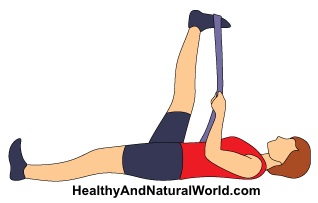
Yoga Stretches to Release the Psoas Muscle
Many yoga stretches are perfect for releasing tension and hurting from your psoas muscle. When performed on a regular basis, these yoga stretches can help manage the symptoms of acute and chronic low dorsum pain. They will help to improve muscle tone and ameliorate your overall feeling of well-beingness.
Boat pose
The first yoga stretch we will look at to release tension and tightness in your psoas muscle is the boat pose. This is an excellent stretch to release a tight or overstretched psoas muscle.
This exercise helps to strengthen your cadre and build stamina in the psoas muscles. Because of the extra force in your core, the gunkhole pose volition assist y'all maintain improve remainder.
The main focus of the boat pose in strengthening your psoas musculus is to keep your spine direct while trying to straighten your legs.
How to do the boat pose to release psoas muscle tightness:
- Sit on the flooring with your anxiety flat on the floor and your knees bent.
- Keeping your knees bent, elevator your feet off the floor.
- Slowly extend your legs so that your shins are parallel to the floor.
- At this signal, your upper body volition naturally autumn back. All the same, information technology's important to keep your spine straight.
- Keeping your spine straight, straighten your legs to a 45-degree angle. Your body should now be in a "Five" shape.
- Straighten your arms and roll your shoulders back and concord your arms parallel to the floor.
- Residue on your sit bones and concord your position for at least 5 breaths.
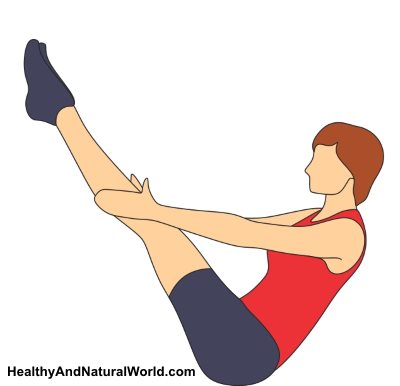
Down facing canis familiaris
The downward facing dog pose is fantabulous yoga stretch to release the psoas musculus. This exercise helps to improve stability and strength in your psoas musculus and lower back.
The downward facing canis familiaris pose helps to flex your spine at the places where the psoas muscles are joined. Information technology also stretches the hamstrings to really help increase the range of motion in your pelvis and lumbar muscles as well as stretching your legs.
How to do the downwards facing domestic dog to strengthen psoas muscles:
- Start on your hands and knees.
- Your wrists should exist direct beneath your shoulders and your knees below your hips.
- Exhale out as yous gently elevator your knees off the flooring until your legs are straight.
- Your body should be in the shape of an "A".
- Endeavour to stretch your pelvis up to the ceiling and lengthen your spine.
- Make sure there is equal pressure through your heels and palms.
- Now, try to draw your shoulder blades into your ribs and toward your tailbone.
- Rotate your arms so that your thumbs are pointing in front of you.
- Agree for at least five breaths.
- As y'all return to the starting position, exhale slowly.
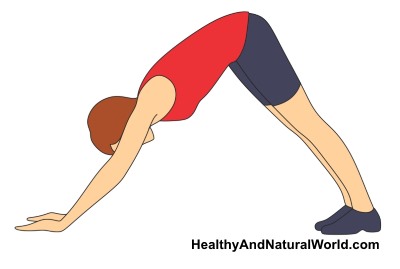
Child'due south pose
The child's pose is a popular yoga stretch to appoint your psoas muscles and increase strength in your lumbar region. This helps to lengthen your spine as well as stretching your hips and relaxing your whole body.
How to perform the kid's pose to alleviate tension and tightness in your psoas muscle:
- Accept up a kneeling position and have your heels direct under your buttocks. Your big toes should be touching.
- Lean your upper trunk frontward and place your arms straight in front of you lot.
- Your brow should touch the ground.
- Breathe in securely 10 times making certain that your rib cage expands and contracts.
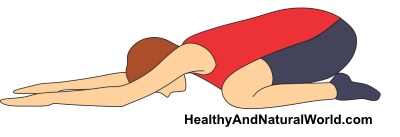
Chair pose
The chair pose is a great yoga technique to strengthen your psoas muscles and also increment strength and flexibility in your lower back. You volition find that the more y'all practice this yoga pose, the easier information technology becomes. The result should exist that you volition have less lower dorsum pain and stiffness.
The chair pose helps to strengthen your abdominal muscles, lower back, thighs, and glutes.
How to practice the chair pose to release the psoas muscle:
- Stand direct with your shoulders back.
- Lift your arms above your head and turn your palms and then they are facing each other.
- Bend at the knees and allow your pelvis drop as if you lot were about to sit.
- Concord for 5-ten breaths so return to the starting position.
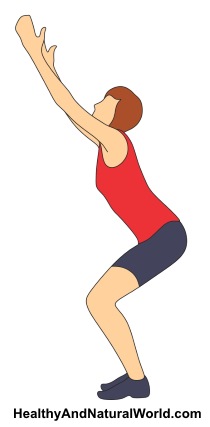
Massaging the Psoas Major and Iliacus (Iliopsoas) Muscles to Relieve Tension
One manner to assistance release your psoas muscles and ease lower dorsum pain is to massage the psoas major and iliacus muscles. This helps to become rid of trigger points that can be causing referred pain and also helps to ease muscle tension.
However, for an untrained person, it can be a challenge to locate the exact location of the psoas musculus. In that location are likewise many important organs in your abdominal area and y'all could damage one of them if you start massaging or pressing on the wrong identify.
To help release tension in your lower back, you can perform a gentle self-massage on your abdomen. The best mode to do this is to employ a roller ball or tennis ball. Your psoas muscles are located about 2 inches on either side of your abdomen button. Gently press the lawn tennis ball into your belly and run it in a straight line towards your pelvis and back again.
Read my other related manufactures:
- How to Employ Tennis Ball to Salvage Sciatic Pain and Back Pain
- Effective Treatments for Pulled, Strained or Torn Back Muscle
- The Best Yoga Stretches To Soothe Your Dorsum Pain
Article Sources
- J Am Osteo Donkey. 2022 August;112: 522-528.
- J Can Chiropr Assoc. 2009 Dec; 53(four): 311–318.
- ClevelandClinic. Psoas syndrome.
- Eur Spine J. 2022 Sep; 22(9): 1965–1971.
- J Human being Manip Ther. 2007; 15(4): 203–215.
Source: https://www.healthyandnaturalworld.com/psoas-muscle/
Posted by: smileymeltairred.blogspot.com


0 Response to "How To Repair A Psoas Mscle Tear"
Post a Comment